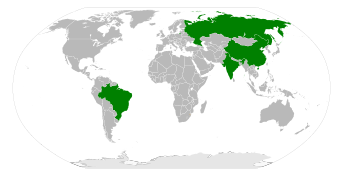You may have heard of the Holocene epoch but have you heard of the Anthropocene, the so-called new epoch of geological time? The Anthropocene can be defined as the epoch in which human activity has been shaping the earth.
The idea was first proposed in the 1870s by an Italian geologist called Antonio Stoppani but his theory was rejected by other scientists because they thought it was unscientific. This may have been because the impact of humans at the time was localised and the impacts of anthropogenically caused climate change were not yet known. In the year 2000, however, Dr Paul Crutzen suggested we are now in the Anthropocene and many scientists took him seriously; the proposal of a new epoch was presented to the International Commission on Stratigraphy, which is the organisation that decides when geological epochs start and finish.
Evidence of the Anthropocene?
Fossils
The main way of identifying periods of geological time is to examine fossils. Many scientists say that the fossils we leave behind will be vastly different from those of the past. For instance, because of human land use in the UK, there will be a decrease in fossils of the country’s
climax community (deciduous forests) and an increase in agricultural related fossils. Some scientists suggest there will even be fossils of cities, but others say this would be highly unlikely as cities are built on land, where erosional processes have a greater influence than sedimentation, which normally leads to fossils being created. Nevertheless, Dr Mike Ellis says that cities may be buried due to sea level rise – he may have forgotten that not all cities are on the coast!
Climate Change
In recent times anthropogenically caused climate change has played a significant role in the shaping of some landscapes. For example, the melting of glaciers in the Himalayas is now widely believed to have been contributed to by greenhouse gas emissions causing global warming. This melting has led to increased erosion of the earth’s surface.
Nitrogen Cycle
The
Nitrogen Cycle has been severely affected by humans, in particular through the production and use of fertiliser. This is needed for farming because when crops are harvested, it interrupts the natural recycling of nitrogen (which would normally occur when plants decompose). Fertiliser leaches into river systems causing algae blooms and this can result in fish being starved of oxygen. More importantly, the use of fertiliser has allowed the human population of the planet to expand, reaching 7 billion this week.
However…
Some scientists argue that we cannot just decide when a new epoch has started. Geology is a historical science therefore an epoch cannot be determined based on predictions. Moreover, no one can even decide on a start date for the Anthropocene, with different disciplines arguing different dates depending on the particular evidence they have studied. For example, some ecologists may claim that the Anthropocene began with the development of agriculture around 8,000 years ago; whereas scientists interested in recent climate change may suggest that it began with the Industrial Revolution in the late 1800s.
Does it Matter Anyway?
As many of the processes occurring today do not resemble the Holocene (the epoch we may still be in if the Anthropocene does not exist), it may be useful for many scientists to use the word ‘Anthropocene’ to indicate the period of recent time in which humans have had a significant impact on the earth’s surface. Some even argue that it is important because it helps emphasise the severity of human impacts on the world and may encourage people to change their behaviour. Personally I do not think that the International Commission on Stratigraphy should formalise the Anthropocene as a new epoch when we cannot yet be certain of whether or when it has actually started. It is for future generations to decide when all the evidence is present – that is if humans are still around by then!
Imogen 13W







